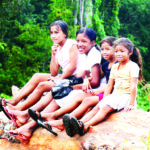Home Features Christmas in an Indigenous village: A time for preserving traditions of our...
By Leah Hernandez
Dating back thousands of years ago, our Indigenous people are known for their unique and exquisite heritage. That heritage is displayed in each encounter one would have with our first people, whether it be through their craft or way of life.
However, despite their rich culture, our country’s first inhabitants began fighting some years ago (and still are presently) to preserve all their ancestral teaching owing to rapid urbanisation in most interior regions. 
Nevertheless at the same time, some of our Indigenous people are determined to overlook such and cling to the traits that make them so unique. Such can be used to described the tight-knit community of Four Miles, located in Port Kaituma, Region One (Barima-Waini).
This over 800 population has chosen to strongly display their uniqueness through Christmas, one of the most festive and busiest seasons of the year.
Leader of the Four Miles Village, Toshao Lloyd Adolphus, in an interview with Guyana Times elaborated on how the community, as a whole, worked towards preserving their cultures and traditions as well as the atmosphere on Christmas, Boxing and New Year’s Day.
Adolphus shared that instead of purchasing chicken which is widely used for the pepper-pot dish in the city, males (both young and old) within the community would normally set out to hunt for wild meat (namely labba, deer, wild hog, or accuri) since these would add extra flavour and variety to the dish, but most importantly maintain a mean of survival practised by their ancestors to complement substantial farming.
Another form of preservation is seen through the use of freshly-baked soft cassava bread with pepper-pot on Christmas morning complemented by locally-made drink( either piwari or potato wine), moving away from the typical breakfast combination of homemade bread and tea/juice. And according to Toshao Adolphus, the closely-arranged houses in the community offer villagers the opportunity to not only visit but to share among themselves something done yearly.
This led to the Indigenous leader sharing one tradition that never changed during his childhood days.
“From since I know myself, during my youth, one thing I’ve learnt is that every Christmas especially during the nights or even the day we always visit each other. And whoever family we visit, they share with us and whoever pays us a visit we share with them,” he explained
Like the coastland’s population, this Indigenous community starts their Christmas preparations by way of cleaning and house rearranging. However, unlike the range of activities listed to be done on Christmas and Boxing Day in the city, these locals usually prefer to spend the time with their families or other relatives.
But during periods leading up to the highly-anticipated December 25, the religious community would spread cheer to young children through the hosting of special parties and distribution of toys. For adults, gift exchanges are usually agreed on.
Adolphus, who is also a religious leader, went on to share that the majority of the community’s populace ends the old year and celebrates the start of the new one by partaking in their traditional church service.
“Old Year’s Night, we have church. We come together, cook different foods and have a great time in church until sometime around 1:00 am in the morning” he communicated.
The quiet and relaxing atmosphere continues on New Year’s Day, as it is mainly utilised for rest followed by the community gathering in the evening to generally welcome new beginnings.
An excited Adolphus is spending this Christmas as the first since being elected Toshao; this is among the many reasons why he has his heart set on dwelling with his community more for this festive season.
“My heart is with going to the different churches throughout the villages, visiting some during the day and other during the night and having an enjoyable moment with the rest of the villagers for this Christmas,” the Toshao shared
His Christmas message to Guyanese and the entire Indigenous community is to: “Live happily together, respect each other, work together and cooperate with each other so we can go to a higher level within the village and everywhere else.”


